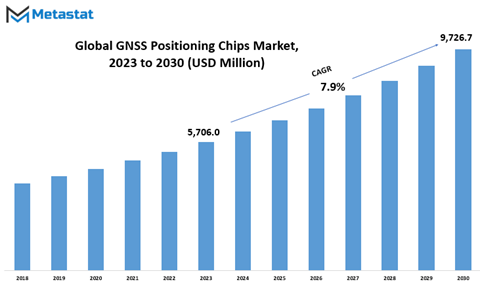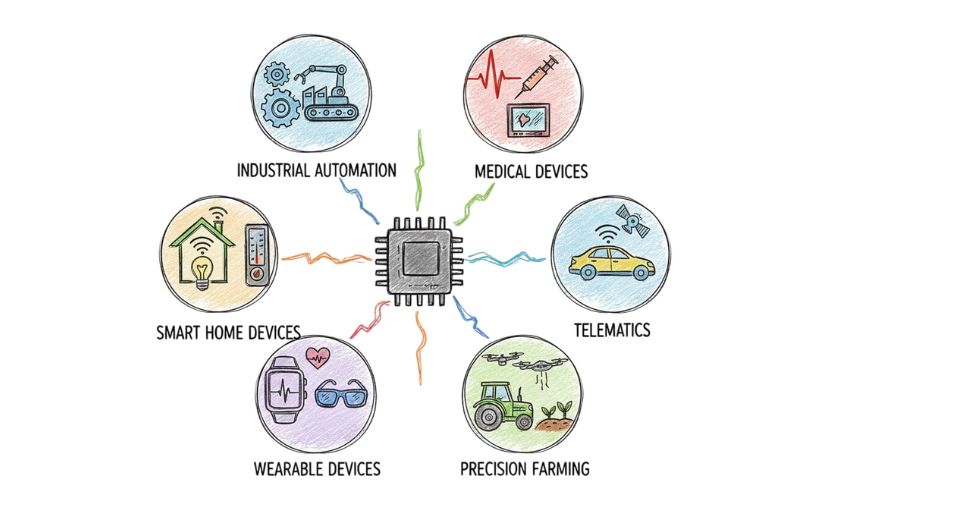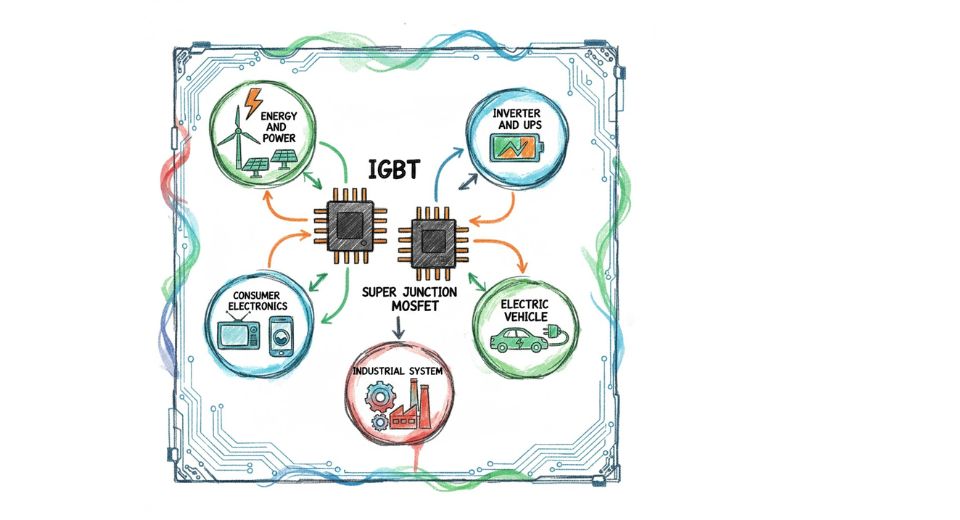MARKET OVERVIEW
The GNSS Positioning Chips Market has become an integral part of modern technology and infrastructure. GNSS positioning chips are integrated circuits designed to calculate accurate location and timing data from signals sent by global constellations like GPS, Galileo, GLONASS, and BeiDou. With their low power consumption, small form factors and affordability, GNSS chips have been incorporated into smartphones, wearables, autonomous vehicles and industrial equipment.
The utility of precise location data enables features like navigation, mapping, asset tracking, and location-based services. Timing data from GNSS chips is vital for telecommunications, banking and electrical grid management. Emerging technologies like autonomous vehicles, drones, augmented reality, and the Internet of Things are surging demand for reliable, high-precision GNSS chipsets.
Major factors driving the GNSS positioning chip market growth include smartphone and consumer device proliferation, automotive and autonomous vehicle adoption, critical infrastructure integration, and demand from agriculture and surveying. Key players are investing heavily in research and development to improve accuracy, reduce size, and add new capabilities.
As location-aware technology becomes ubiquitous worldwide, the market for high-performance GNSS positioning chips continues to grow in importance. With applications across consumer, commercial, industrial and military domains, GNSS chip technology enables the positioning and timing that underpins vital modern innovations. The market outlook remains positive as new constellations deploy, and chips become more versatile and affordable.
Global GNSS Positioning Chips market is estimated to reach $9,726.7 Million by 2030; growing at a CAGR of 7.9% from 2023 to 2030.

GROWTH FACTORS
The GNSS positioning chips market is experiencing a notable upswing, primarily fueled by the surging demand for location-based services. In an age where our reliance on location-based information has become indispensable, these chips play a pivotal role in enabling the seamless functioning of various applications. Whether it's navigating through city streets or checking in at a local coffee shop, the increasing demand for location-based services is steering the growth of the GNSS positioning chips market.
Another significant driver in this landscape is the continuous advancements in autonomous vehicles. As the automotive industry propels toward autonomy, the need for highly accurate and reliable positioning becomes paramount. GNSS positioning chips, with their ability to provide precise location data, are at the forefront of supporting the evolution of autonomous vehicles. From enhancing navigation systems to enabling effective route planning, these chips are a linchpin in the technological progression of self-driving cars.
However, amidst this promising trajectory, the market grapples with certain restraints. Signal interference and inaccuracy pose notable challenges to the efficacy of GNSS positioning chips. In real-world scenarios, factors such as tall buildings or dense foliage can interfere with the signals, leading to inaccuracies in the positioning data. This limitation necessitates ongoing innovation to overcome signal-related hurdles and ensure the reliability of location information.
Cost and power consumption stand as additional hurdles in the widespread adoption of GNSS positioning chips. While the demand for these chips is escalating, addressing concerns related to cost-effectiveness and power efficiency becomes imperative. Striking a balance between delivering high-performance chips and ensuring economic viability is a critical factor that market players need to navigate.
Amidst these challenges, a compelling opportunity arises in the form of the growing demand for precision agriculture. As the agriculture sector undergoes a technological transformation, precision becomes the key to optimizing farming practices. GNSS positioning chips, with their ability to provide accurate and real-time location data, offer immense potential in revolutionizing precision agriculture. From guiding tractors with pinpoint accuracy to optimizing irrigation systems, these chips are poised to play a pivotal role in shaping the future of agriculture.
The GNSS positioning chips market is a dynamic arena shaped by the interplay of increasing demand for location-based services, advancements in autonomous vehicles, and the challenges posed by signal interference, inaccuracy, cost, and power consumption. The silver lining lies in the burgeoning opportunity presented by the growing demand for precision agriculture, marking a transformative phase in the role of GNSS positioning chips across various industries.
MARKET SEGMENTATION
By Device Type
In the expansive landscape of GNSS positioning chips, the market delineates its contours through the segmentation of device types. This segmentation, a pivotal aspect of market dynamics, categorizes devices into distinct classes, catering to diverse user needs and technological applications.
The primary segmentation unfolds across device types, where the GNSS positioning chips find their niche utility. The market designates its presence in Smartphones, Tablets & Wearables, Personal Tracking Devices, and Low-Power Asset Trackers. Each of these segments encapsulates unique functionality and addresses specific requirements in the broader spectrum of location-based technology.
Smartphones, a ubiquitous element in modern life, integrate GNSS positioning chips seamlessly, empowering location-based services that range from navigation to location sharing. The marriage of GNSS chips with Smartphones enhances not only user convenience but also the efficiency of various applications dependent on precise location data.
Tablets & Wearables, another facet of this technological tapestry, incorporates GNSS chips to provide users with an extended range of location-centric features. From fitness tracking in wearables to navigation in tablets, these devices leverage GNSS technology to augment their functionalities.
Personal Tracking Devices, a category witnessing a surge in demand, employs GNSS positioning chips to provide real-time location tracking for individuals. Whether it's for ensuring the safety of loved ones or tracking valuable possessions, the integration of GNSS chips amplifies the accuracy and reliability of these tracking devices.
Low-Power Asset Trackers, an emerging segment in the GNSS positioning chips market, caters to the need for efficient and prolonged tracking of assets. The integration of GNSS chips in low-power asset trackers ensures a balance between precision and energy consumption, making them suitable for a range of applications, from logistics to supply chain management.
The segmentation into these device types not only reflects the diversity of applications but also underscores the adaptability of GNSS positioning chips across various technological domains. This market-driven categorization aligns with the evolving needs of consumers and industries, mirroring the dynamic nature of location-based technology.
By Application
In the ever-expanding realm of technology, one crucial aspect that often goes unnoticed but plays a pivotal role in our daily lives is the GNSS Positioning Chips Market. This market, marked by its diverse applications, has experienced substantial growth in recent years. The applications of these chips are varied, catering to different needs in the tech landscape.
A significant chunk of the GNSS Positioning Chips Market is dedicated to navigation. In 2022, the Navigation segment raked in a substantial value of 1708.4 USD Million. These chips, embedded in devices we use daily, facilitate seamless navigation, guiding us through the intricacies of our surroundings.
Mapping, another vital application of GNSS Positioning Chips, accounted for 909.1 USD Million in 2022. These chips contribute to the creation of accurate and up-to-date maps, enhancing our understanding of geographical layouts and aiding in various fields, from urban planning to environmental monitoring.
Location-Based Services (LBS) represent another facet of this market, with a valuation of 707.2 USD Million in 2022. These services, made possible by GNSS Positioning Chips, have become integral in our lives, enabling personalized information and assistance based on our geographical location.
Surveying, a field where precision is paramount, benefits significantly from GNSS Positioning Chips. The applications extend beyond traditional uses, finding utility in telematics, contributing to the efficiency of fleet management systems.
The Timing and Synchronization segment further exemplifies the versatility of GNSS Positioning Chips, ensuring that various devices and systems operate in perfect harmony, synchronized to the precise time. This functionality is crucial in numerous industries, from telecommunications to scientific research.
Beyond these primary applications, GNSS Positioning Chips find utility in a myriad of other areas, contributing to the functionality of devices and systems we encounter daily. The market's growth is indicative of the indispensable role these chips play in our technologically driven society. As we move forward, the GNSS Positioning Chips Market is poised to continue its upward trajectory, shaping our technological landscape with its diverse and indispensable applications.

By End-User
The GNSS positioning chips market exhibits a diverse landscape, segmented by end-users to cater to distinct industry needs. Among these segments, the automotive sector stands out, boasting a valuation of 2415.8 USD Million in 2022. This robust figure underscores the critical role of GNSS technology in modern automotive systems, contributing to enhanced navigation and location-based services.
Moving beyond the roads, the aerospace and defense segment also commands a significant share, with a valuation of 1015.7 USD Million in 2022. This sector's reliance on precise positioning for navigation and tracking aligns seamlessly with the capabilities of GNSS positioning chips.
The maritime industry, not to be overshadowed, stakes its claim in the GNSS positioning chips market with a valuation of 489.7 USD Million in 2022. As ships traverse vast expanses of water, the need for accurate and reliable positioning becomes paramount, driving the adoption of GNSS technology.
Rail, agriculture, and other sectors form additional pillars in this market, each with its unique set of demands and applications. The rail industry, for instance, integrates GNSS technology to optimize train routing and improve overall efficiency. In agriculture, GNSS positioning chips contribute to precision farming, enabling farmers to enhance crop yield through targeted and efficient field operations.
In the broader category of others, various industries find value in GNSS positioning chips, leveraging their capabilities to address specific positioning requirements. This diverse range of end-users highlights the adaptability and widespread applicability of GNSS technology across different sectors.
The GNSS positioning chips market, segmented by end-users such as automotive, aerospace & defense, maritime, rail, agriculture, and others, reflects the dynamic nature of modern technology adoption. As industries continue to evolve, the demand for accurate and reliable positioning solutions is set to grow, further driving the expansion of the GNSS positioning chips market across diverse sectors.
REGIONAL ANALYSIS
The GNSS Positioning Chips market is geographically segmented into North America and Europe. This division is pivotal in understanding the market dynamics and trends that influence the demand and supply of GNSS Positioning Chips.
In North America, the GNSS Positioning Chips market exhibits a robust presence, driven by the region's technological advancements and widespread adoption of navigation systems across various industries. The demand for precise positioning information, crucial for applications ranging from automotive navigation to precision agriculture, propels the market forward in this region.
Similarly, in Europe, the GNSS Positioning Chips market showcases a significant footprint. The European market is characterized by a burgeoning need for accurate location data in sectors such as transportation, logistics, and defense. The integration of GNSS technology into everyday applications and devices contributes to the sustained growth of the market in Europe.
The market's geographical segmentation enables a focused analysis of regional trends, regulatory landscapes, and the economic factors influencing the GNSS Positioning Chips market in North America and Europe. Understanding the unique demands and preferences of each region is instrumental in tailoring products and strategies to meet the specific requirements of diverse markets.
The North American and European markets, while sharing similarities in the adoption of GNSS technology, also exhibit distinct nuances shaped by regional factors. These factors include regulatory frameworks, industrial landscapes, and the prevalence of key market players. The geographical division allows stakeholders to gain insights into the localized intricacies that impact market dynamics.
As technology continues to advance, the GNSS Positioning Chips market in North America and Europe remains dynamic, responding to evolving consumer needs and industry trends. The geographical segmentation provides a lens through which industry participants can navigate the diverse landscape, ensuring adaptability and relevance in both the North American and European markets.
COMPETITIVE PLAYERS
In the dynamic landscape of the GNSS Positioning Chips market, key players play a pivotal role in steering the industry forward. Among these influential figures, Qualcomm Incorporated and MediaTek Inc. stand out as notable contributors.
Qualcomm Incorporated, a leading player in the GNSS Positioning Chips market, has carved a niche with its innovative technologies. The company's commitment to advancing location-based services is evident in its cutting-edge GNSS solutions. Qualcomm's positioning chips not only offer accurate location data but also integrate seamlessly with a variety of devices, ensuring widespread applicability.
Another prominent player, MediaTek Inc., has been a driving force in the GNSS Positioning Chips industry. Known for its diverse portfolio of semiconductor products, MediaTek has made significant strides in the development of positioning chips. These chips boast not only high precision but also energy efficiency, addressing the growing demand for sustainable solutions in the market.
The synergy between Qualcomm Incorporated and MediaTek Inc. reflects the competitive dynamics within the GNSS Positioning Chips industry. Both companies bring unique strengths to the table, fostering a healthy environment for technological innovation and market growth. As key players, their contributions extend beyond individual achievements, influencing the trajectory of the entire GNSS Positioning Chips market.
GNSS Positioning Chips Market Key Segments:
By Device Type
- Smartphones
- Tablets & Wearables
- Personal Tracking Devices
- Low-Power Asset Trackers
By Application
- Navigation
- Mapping
- Location-Based Services
- Surveying
- Telematics
- Timing and Synchronization
- Others
By End-User
- Automotive
- Aerospace & Defense
- Maritime
- Rail
- Agriculture
- Others
Key Global GNSS Positioning Chips Industry Players
- Qualcomm Incorporated
- MediaTek Inc.
- U-Blox Holding AG
- Broadcom Limited
- Furuno Electric Co., Ltd.
- Unicore Communications, Inc.
- Wuhan Mengxin Technology Co., Ltd.
- Allystar Technology (Shenzhen) Co., Ltd.
- Taidou Microelectronics Technology Co., Ltd. (Techtotop)
- Sony Semiconductor Solutions Corporation
WHAT REPORT PROVIDES
- Full in-depth analysis of the parent Industry
- Important changes in market and its dynamics
- Segmentation details of the market
- Former, on-going, and projected market analysis in terms of volume and value
- Assessment of niche industry developments
- Market share analysis
- Key strategies of major players
- Emerging segments and regional growth potential








 US: +1 3023308252
US: +1 3023308252






